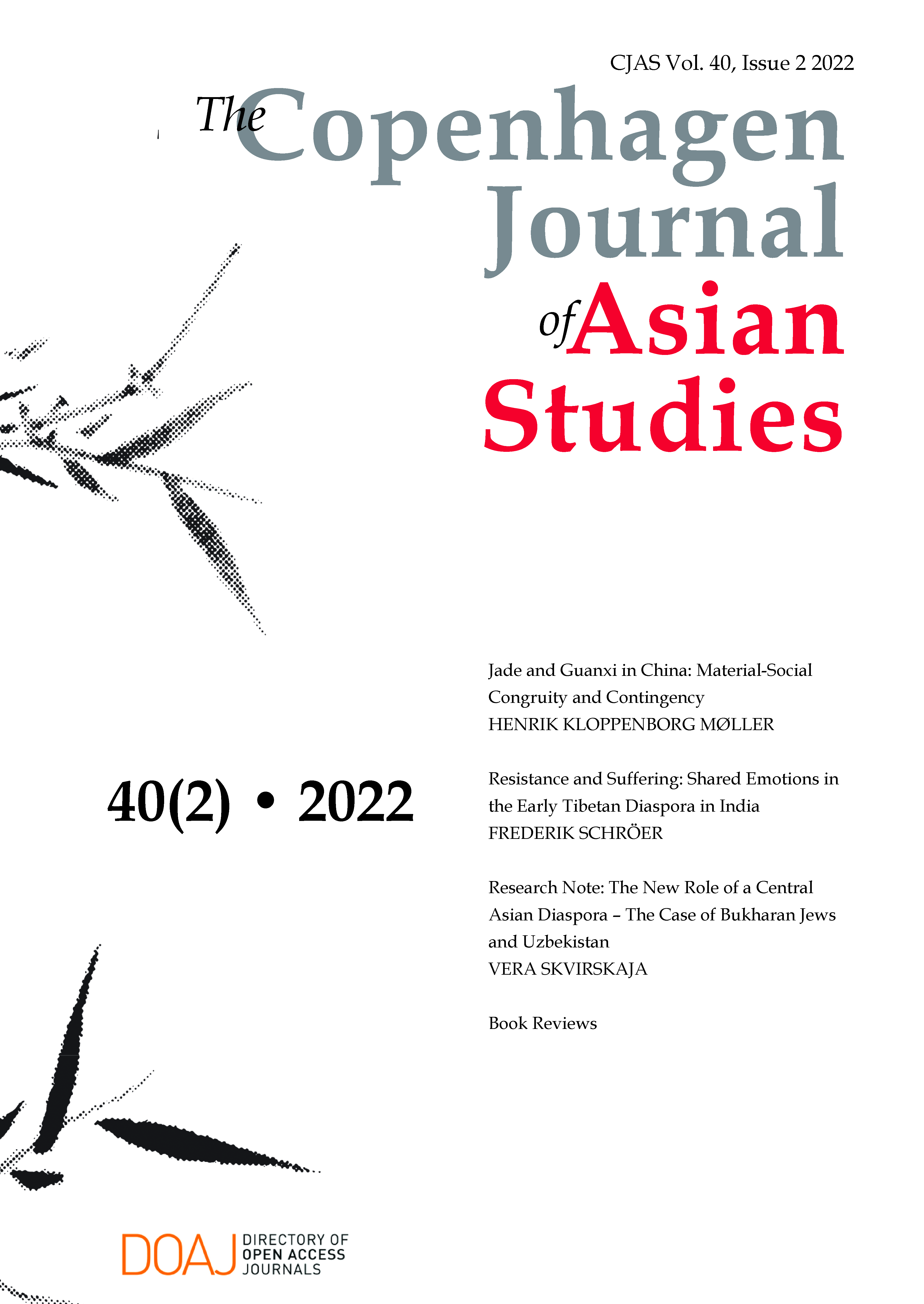Jade and Guanxi in China
Material-Social Congruity and Contingency
DOI:
https://doi.org/10.22439/cjas.v40i2.6745Keywords:
markets, gemstones, ontology, materiality, personal trust, instrumentality, affect, social relationshipsAbstract
This article discusses how the gemstone jade mediates guanxi (‘personal relationships’), and how guanxi mediates jade trade in China. Outlining some affective, spiritual, moral and somatic meanings and efficacies of jade, especially as a gift, the article first discusses how jade materialities, cultural history and ontology influence human interactions with, and through, jade in contemporary China. Secondly, the article presents some more economically instrumental investments in, and exchanges of, jade and discusses why and how a national anti-corruption campaign engendered fluctuations in Chinese jade markets. Finally, the article discusses how guanxi ideally forges personal trust that facilitates transactions of jade, even though some younger jade traders consider guanxi insincere. Studies of guanxi in China’s reform era have conventionally given analytical primacy to how social relationships structure and give meaning to material exchanges. In contrast, this article argues that jade itself can be a catalyst for social relationships that span affect and instrumentality. Combining object–oriented, ontological and institutionalist approaches, the article conceptualises the outlined relations between jade and guanxi as material–social congruity and contingency in the Chinese context.
References
Appadurai, Arjun 1986. ‘Introduction: Commodities and the Politics of Value’. In A. Appadurai (ed.) The Social Life of Things: Commodities in a Cultural Perspective. Cambridge: Cambridge University Press, pp. 1-64. https://doi.org/10.1017/CBO9780511819582.
Bunkenborg, Mikkel, Morten Nielsen and Morten Axel Pedersen 2022. Collaborative Damage: An Experimental Ethnography of Chinese Globalization. Ithaca, NY: Cornell University Press. https://doi.org/10.1515/9781501759819.
Chang, Wen-Chin 2006. ‘The Trading Culture of Jade Stones Among the Yunnanese in Burma and Thailand, 1962-88’. Journal of Chinese Overseas 2 (2): 269-293. https://doi.org/10.1163/179325406788639589.
Chang, Wen-Chin 2008. ‘The Interstitial Subjectivities of the Yunnanese Chinese in Thailand’. The Asia Pacific Journal of Anthropology 9 (2): 97-122. https://doi.org/10.1080/14442210802023632.
Chang, Wen-Chin 2011. ‘From a Shiji Episode to the Forbidden Jade Trade During the Socialist Regime in Burma’. In E. Tagliacozzo and W-C. Chang (eds.) Chinese Circulations: Capital, Commodities, and Networks in Southeast Asia. Durham and London: Duke University Press, pp. 455-480. https://doi.org/10.1215/9780822393573-020.
Cook, Joanna 2013. ‘Ethnographic Enterprise and the Quality of Non-dualism’. Critique of Anthropology 33 (3): 330-335.
Descola, Philippe 2013a. The Ecology of Others. Transl. Geneviève Godbout and Benjamin P. Luley. Chicago: Prickly Paradigm Press.
Descola, Philippe 2013b. Beyond Nature and Culture. Transl. Janet Lloyd. London: University of Chicago Press. https://doi.org/10.7208/chicago/9780226145006.001.0001.
Geertz, Clifford 1963. Peddlers and Princes: Social Development and Economic Change in Two Indonesian Towns. London: Chicago University Press.
Global Witness 2015. Jade: Myanmar’s ‘Big State Secret’. London: Global Witness Limited.
Humphrey, Caroline 2018. ‘Introduction: Trusting and Mistrusting Across Borders’. In C. Humphrey (ed.) Trust and Mistrust in the Economies of the China-Russia Borderlands. Amsterdam: Amsterdam University Press, pp. 9–37. https://doi.org/10.2307/j.ctt22zmbb1.4.
Kam, Louie and Louise Edwards 1994. ‘Chinese Masculinity: Theorizing Wen and Wu’. East Asian History 8: 135-148.
Kipnis, Andrew 1997. Producing Guanxi: Sentiment, Self and Subculture in a North China Village. Durham and London: Duke University Press.
Kipnis, Andrew 2002. ‘Practices of Guanxi Production and Practices of Ganqing Avoidance’. In T. Gold, D. Guthrie and D. Wank (eds.) Social Connections in China: Institutions, Culture and the Changing Nature of Guanxi. Cambridge, N.Y.: Cambridge University Press, pp. 21-37. https://doi.org/10.1017/CBO9780511499579.003.
Ledeneva, Alaina 2008. ‘Blat and Guanxi: Informal Practices in Russia and China’. Comparative Studies in Society and History 50 (1): 118-44. https://doi.org/10.1017/S0010417508000078.
Matthews, William 2017. ‘Ontology with Chinese Characteristics: Homology as a Mode of Identification’. Hau: Journal of Ethnographic Theory 7 (1): 265-285. https://doi.org/10.14318/hau7.1.020.
Møller, Henrik Kloppenborg 2019. Spectral Jade: Materiality, Conceptualisation, and Value in the Myanmar-China Jadeite Trade. Ph.D. dissertation, Lund University.
Naylor, Thomas 2010. ‘The Underworld of Gemstones: Part I - Under the Rainbow’. Crime, Law and Social Change 53 (2): 131-158. https://doi.org/10.1007/s10611-009-9223-z.
Oak, Yan Naung 2018. ‘Even with New Data, Valuing Myanmar's Jade Industry Remains a Challenge’. Natural Resource Governance Institute. https://openjadedata.org/stories/how_much_jade_worth.html (Accessed May 2022).
Osburg, John 2013. Anxious Wealth: Money and Morality Among China’s New Rich. Stanford: Stanford University Press.
Oxfeld, Ellen 2010. Drink Water, But Remember the Source: Moral Discourse in a Chinese Village. Berkeley and Los Angeles: University of California Press. https://doi.org/10.1525/california/9780520260948.001.0001.
Raffles, Hugh 2010. Insectopedia. New York: Pantheon Books.
Reed, Adam 2007. ‘“Smuk is King”. The Action of Cigarettes in a Papua New Guinea Prison’. In A. Henare, M. Holbraad and S. Wastell (eds.) Thinking through Things: Theorising Artefacts Ethnographically. London and New York: Routledge, pp. 32-47.
Van Schendel, Willem 2002. ‘Geographies of Knowing, Geographies of Ignorance: Jumping Scale in Southeast Asia’. Environment and Planning D: Society and Space 20: 647-668. https://doi.org/10.1068/d16s.
Wank, David 2000. ‘Cigarettes and Domination in Chinese Business Networks: Institutional Change During the Market Transition’. In D. Davis (ed.). The Consumer Revolution in Urban China. Berkeley: University of California Press, pp. 268-286.
Yan, Yunxiang 1996. The Flow of Gifts: Reciprocity and Social Networks in a Chinese Village. Stanford: Stanford University Press.
Yan, Yunxiang 2011. ‘The Changing Moral Landscape’. In A. Kleinman et. al. (eds.) Deep China: The Moral Life of the Person. What Anthropology and Psychiatry Tell Us About China Today. Berkeley and Los Angeles: University of California Press, pp. 36-77.
Yan, Yunxiang 2012. ‘Food Safety and Social Risk in Contemporary China’. The Journal of Asian Studies, 71 (3): 705–729. https://doi.org/10.1017/S0021911812000678.
Yang, Mayfair Mei-Hui 1994. Gifts, Favours, and Banquets: The Art of Social Relationships in China. Ithaca: Cornell University Press.
Yu, Ming 2009. Chinese Jade. Cambridge: Cambridge University Press.
Zhang, Jinghong 2014. Puer Tea: Ancient Caravans and Urban Chic. Seattle and London: University of Washington Press.
Zheng, Tiantian 2006. ‘Cool Masculinity: Male Clients’ Sex Consumption and Business Alliance in Urban China’s Sex Industry’. Journal of Contemporary Culture 15 (46): 161-182. https://doi.org/10.1080/10670560500331815.


